Related Blogs
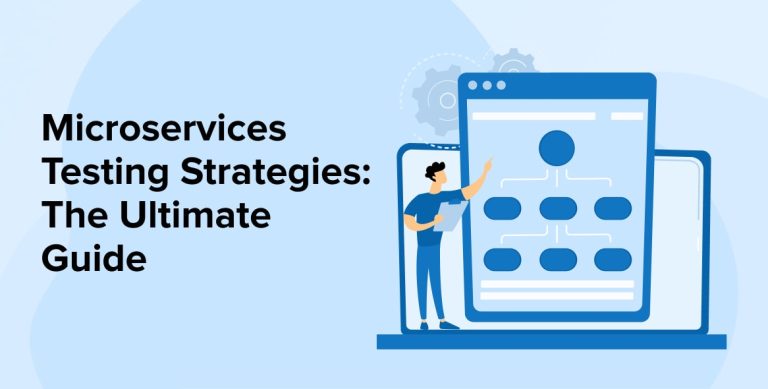
Key Takeaways
- For microservices, formulating an effective testing strategy is a challenging task. A Combination of Testing Strategies with right tools that provide support at each layer of testing is a key.
- Post integration of the service, the risk of failures and cost of correction is high. So a good testing strategy is required.
- Tools like Wiremock, Goreplay, Hikaku, VCR, Mountebank, and many others are used for microservices testing purposes.
- For the effective approach, there should be a clear Consensus on the test strategy. Required amount of testing should be focused at the correct time with suitable tools.
- For the microservices architecture, there is a scope of unit testing, integration testing, component testing, contract testing, and end to end testing. So the team must utilise these phases properly as per the requirements.
In today’s time, software development companies prefer to use the latest approaches for application development, and using microservices architecture is one such initiative. Developers use microservices architecture and divide functional units of the application that can work as individual processes. These singular functions can easily address user traffic and still remain lightweight. But they need to be frequently updated to scale up the application. Besides this, the developers also have to carry out microservices testing strategies to make sure that the application is performing the way it is expected to.
Let’s first understand what types of challenges developers are facing while using a microservices architecture.
1. Challenges in Microservices Testing
Microservices and monolithic architectures have many differences. It also comes with some challenges that every developer should know before testing microservices.
| Challenge | Description |
|---|---|
| Complexity |
|
| Data Integrity |
|
| Distributed Networks |
|
| Test Area |
|
| Multiple frameworks used for development |
|
| Autonomous |
|
| Development |
|
2. Microservices Testing Strategy: For Individual Testing Phases
Now let us understand the testing pyramid of microservices architecture. This testing pyramid is developed for automated microservices testing. It includes five components.
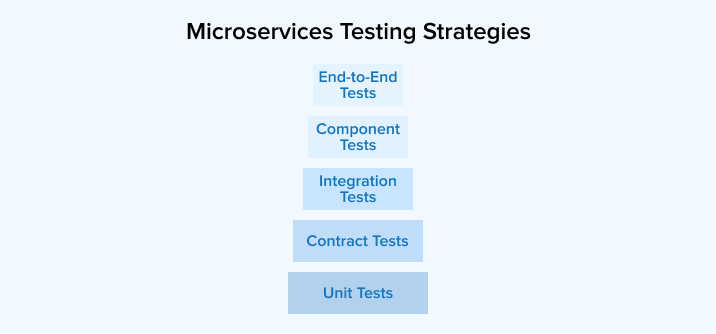
The main purpose of using these five stages in microservices testing is:
| Testing Type | Key Purpose |
|---|---|
| Unit Testing |
|
| Contract Testing |
|
| Integration Testing |
|
| Component Testing |
|
| End-to-End Testing |
|
2.1 Unit Testing
The very first stage of testing is unit testing. It is mainly used to verify the function’s correctness against any specification. It checks a single class or a set of classes that are closely coupled in a system. The unit test that is carried out either runs with the use of the actual objects that are able to interact with the unit or with the use of the test doubles or mocks.
Basically, in unit tests, even the smallest piece of the software solution is tested to check whether it behaves the way it is expected to or not. These tests are run at the class level. Besides this, in unit testing one can see a difference in whether the test is performed on an isolated unit or not. The tests carried out in this type of testing method are written by developers with the use of regular coding tools, the only difference is in its types as shown below.
Solitary Unit Testing:
- Solitary unit tests ensure that the methods of a class are tested.
- It mainly focuses on the test result to always be deterministic.
- In this type of unit testing, collaborations and interactions between an object of the application and its dependencies are also checked.
- For external dependencies, mocking or stubbing to isolate the code is used.
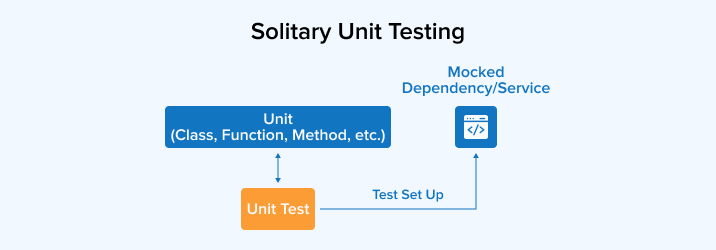
Sociable Unit Testing:
- These tests are allowed to call other services.
- These tests are not deterministic, but they provide good results when they pass.
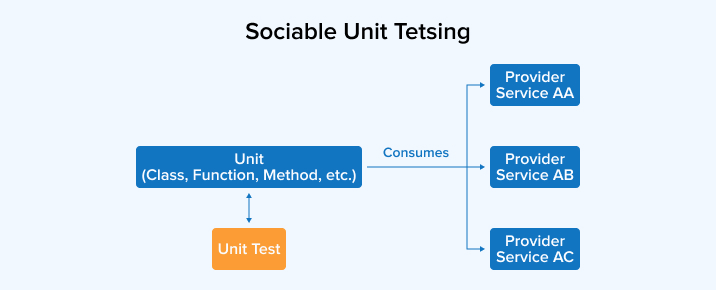
Basically, as we saw here, unit tests when used alone do not offer a guarantee of the system’s behavior. The reason behind it is that in unit testing, the core testing of each module is covered but it doesn’t cover the modules when they are in collaborative mode. Therefore, in such cases, to make sure that the unit tests are run successfully, developers make use of test doubles and ensure that each module works correctly.
2.2 Integration Testing
The second stage of microservices testing is Integration tests. This type of testing is used when the developer needs to check the communication between two or more services. Integration tests are specially designed to check error paths and the basic success of the services over a network boundary.
In any software solution, there are different components that interact with one another as they may functionally depend on each other. Here, the integration test will be used to verify the communication paths between those components and find out any interface defects. All the test modules are integrated with each other and they are tested as a subsystem to check the communication paths in this testing method.
There can be three types of communications that happen in the microservices architecture:
- Between two different microservices
- Between Microservice and third-party application
- Between Microservice and Database
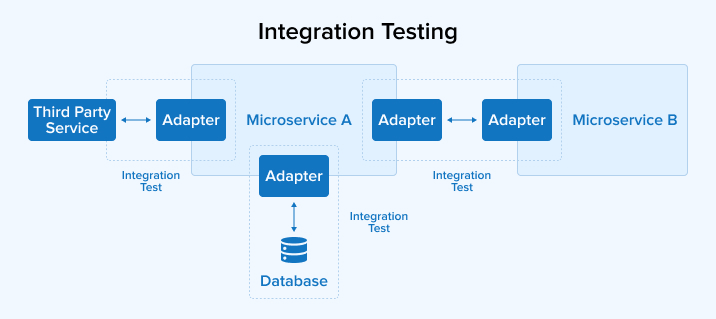
The aim of integration testing is to check the modules and verify if their interaction with external components is successful and safe. While carrying out such tests, sometimes it becomes difficult to trigger the external component’s abnormal behavior like slow response time or timeout. In such cases, special tests are written by the developers to make sure that the test can respond as expected.
Basically, integration tests come with the goal of providing assurance that the coding schema matches the stored data.
2.3 Component Testing
Component tests are popular when it comes to checking the full function of a single microservice. When this type of testing is carried out, if there are any calls made by the code to the external services, they are mocked.
Basically, a component is a coherent, well-encapsulated, and independently replaceable part of any software solution. But when it comes to a microservice architecture, these component tests become a service. This means that developers perform component tests in microservices architecture to isolate any component’s complex behavior.
Besides this, component tests are more thorough in comparison to integration testing as it has the capability to travel on all the paths. For instance, here we can know how the component responds to the network’s malformed requests. This process can be divided into two parts.
In-process Component Testing
- Test runners exist in the same process or thread as microservices.
- Microservices can be started in an offline test mode.
- This testing works only with single-component microservices.

Out-process Component Testing
- Appropriate for any size of components.
- Components here are deployed unaltered in a test environment.
- All dependencies in microservices are stubbed or mocked out.
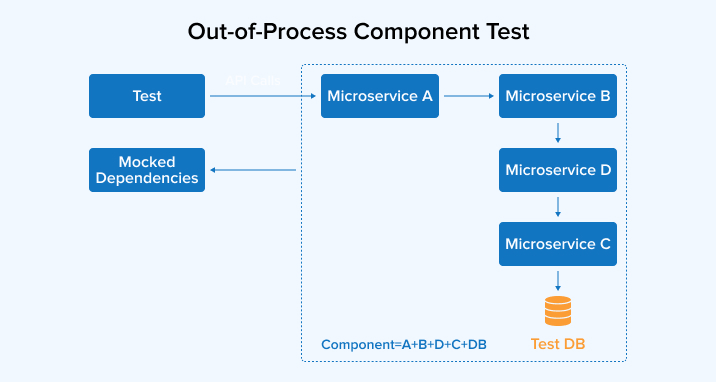
2.4 Contract Testing
This testing type is carried out when two microservices gather via an interface and they need a bond to specify all the possible transactions with their data structures. Here, even the possible side effects of the inputs and outputs are analyzed to make sure that there is no security breach in the future. This type of testing can be run by the client, the producer, or both.

Consumer-side
- The downstream team writes and executes the tests.
- The testing method connects microservices in a mocked version of the producer service.
- Microservices are checked to see if they can consume client-side API.
Producer-side
- Producer-side contract tests run in upstream services. .
- Clients’ API requests are checked along with the producer’s contract details.
2.5 End-to-End Testing
The last type of testing in our list is End-to-End Testing. This approach is used for testing microservices completely. This means that end-to-end testing checks the entire microservices application. It checks whether the system meets the client’s requirements and helps in achieving the goal. When this test is carried out by the developers, it doesn’t bother about the internal architecture of the application but just verifies that the system offers a business goal. In this case, when the software is deployed, it is treated as a black box before getting tested.
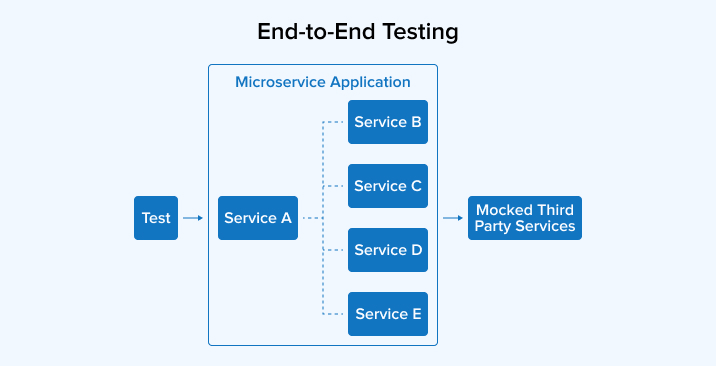
Besides this, as end-to-end testing is more about business logic, it checks the proxies, firewall, and load balancer of the application because generally they are affected by the public interference from API and GUIs. In addition to this, end-to-end testing also helps developers to check all the interactions and gaps that are present in microservice-based applications. This means that testing microservices applications completely can be possible with end-to-end testing.
Now, let’s look at various scenarios and how these phases can apply.
3. Microservices Testing Strategies for Various Scenarios
Here we will go through various microservices testing strategies for different scenarios to understand the process in a better way.
Scenario 1: Testing Internal Microservices Present in the Application
This is the most commonly used strategy to test microservices. Let’s understand this with an example.
For instance, there is a social media application that has two services like
- Selecting Photos and Videos
- Posting Photos and Videos
Both services are interconnected with each other as there is close interaction between them in order to complete an event.
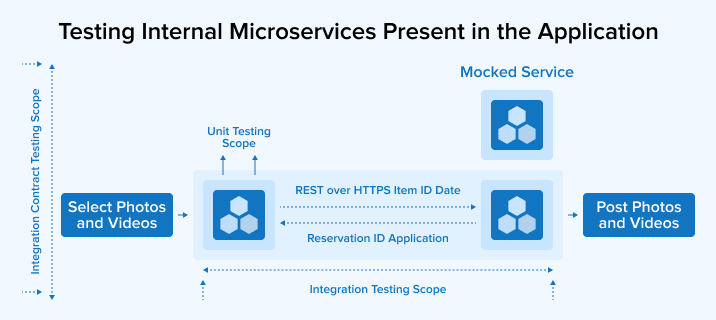
| Testing Scopes | Description |
|---|---|
| Unit Testing |
|
| Integration Testing |
|
| Contract Testing |
|
| End-to-End Testing |
|
Scenario 2: Testing Internal Microservices and Third-party Services
Let’s look at the scenario where third-party APIs are integrated with Microservices.
For Example, in a registration service, direct registration through the Gmail option is integrated. Here registration is modelled as a microservice and interacts with gmail API that is exposed for authenticating the user.
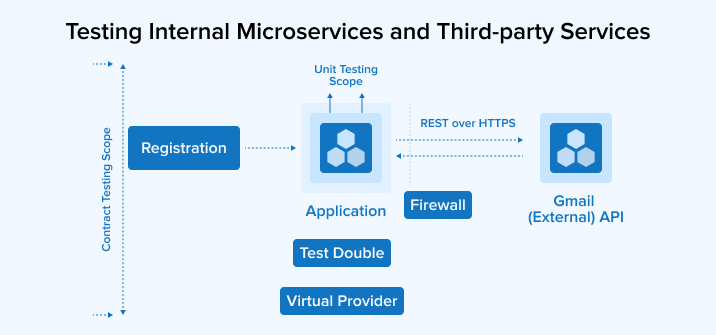
| Testing Scopes | Descriptions |
|---|---|
| Unit Testing |
|
| Contract Testing |
|
| Integration Testing |
|
| End-to-End Testing |
|
Scenario 3: Testing Microservices that are Available in Public Domain
Let’s consider an e-commerce application example where users can check the items’ availability by calling a web API.
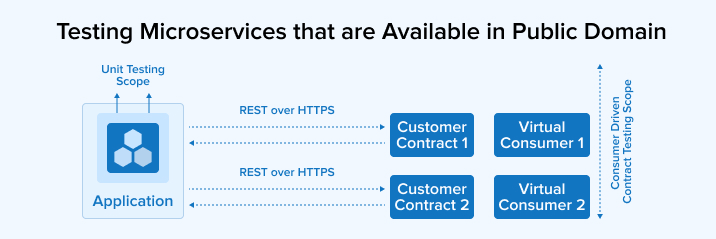
| Testing Scopes | Descriptions |
|---|---|
| Unit Testing |
|
| Contract Testing |
|
| End-to-end Testing |
|
4. Microservices Testing Tools
Here are some of the most popular Microservices testing tools available in the market.
- Wiremock: It is a very popular simulator that is used by developers when they want to do integration tests. Unlike any other general-purpose mocking tool, Wiremock has the capability to work by developing an actual HTTP server that the code that is being tested can connect to as a real web service.
- Goreplay: It is an open-source tool for network monitoring. It helps in recording live traffic of the application and this is why it is used by the developers to capture and replay live HTTP traffic.
- Mountebank: It is a widely used open-source tool that enables software development companies to carry out cross-platform and multi-platform test doubles over the wire. With the help of Mountebank, the developers can simply replace the actual dependencies of the application and test them in the traditional manner.
- Hikaku: It is a very popular test environment for microservices architecture. It helps the developers to ensure that the implementation of REST-API in the application actually meets its specifications.
- VCR: Developers use the VCR tool to record the tests that they carry out on the suite’s HTTP interactions. This recording can be later played for future tests to get accurate, fast, and reliable test results.
5. Conclusion
Microservices testing plays a very important role when it comes to modern software development tactics. It enables developers to offer applications that have greater flexibility, agility, and speed. There are some essential strategies that need to be carried out by the development teams when it comes to testing microservices applications in order to deploy a secure application and some of those microservices testing strategies are discussed in this blog. These automated tests enable the developers to easily cater to customer requirements by offering a top-notch application.

Mohit Savaliya
Mohit Savaliya is looking after operations at TatvaSoft and leverages his technical background to understand Microservices architecture. He showcases his technical expertise through bylines, collaborating with development teams and brings out the best trending topics in Cloud and DevOps.
Subscribe to our Newsletter
Signup for our newsletter and join 2700+ global business executives and technology experts to receive handpicked industry insights and latest news
Build your Team
Want to Hire Skilled Developers?


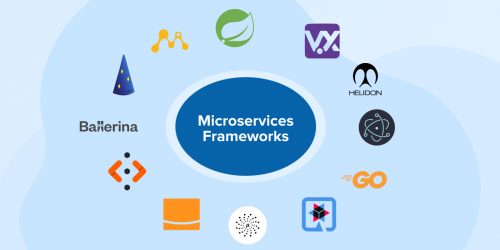
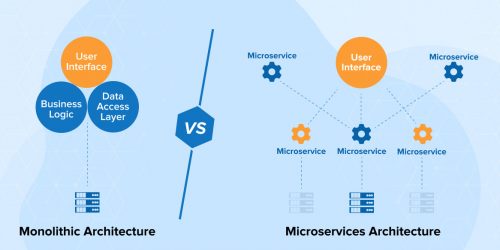

Comments
Leave a message...